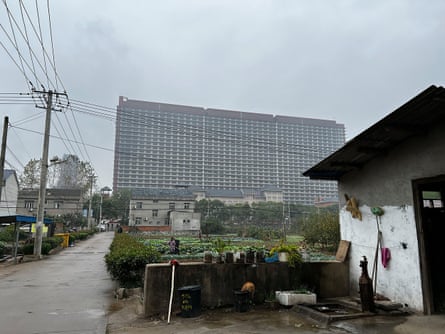On the southern outskirts of Ezhou, a city in central China’s Hubei province, a giant apartment-style building overlooks the main road. But it is not for office workers or families. At 26 storeys it is by far the biggest single-building pig farm in the world, with a capacity to slaughter 1.2 million pigs a year.
This is China’s answer to its insatiable demand for pork, the most popular animal protein in the country.
The new skyscraper-sized farm began production at the start of October when the company behind the facility – Hubei Zhongxin Kaiwei Modern Farming – admitted its first 3,700 sows into the farm.
Zhongxin Kaiwei is a newcomer to the pig sector – and farming. It started out as a cement investor, with multiple cement factories in provinces such as Hubei and Henan. One of them, Hubei Xinshiji Cement, is next to the new pig farm.
The company has said that it originally planned to invest in ready-to-cook food production, but that it changed its mind after a slump in the cement and construction industries in China. Jin Lin, the general manager of the company, has said that the company saw modern agriculture as a promising sector and an opportunity to use its own construction materials to build the pig farm.https://interactive.guim.co.uk/maps/embed/nov/2022-11-10T11:43:47.html
Advertisement
According to statements on the company’s official WeChat account, the pig farm has two buildings. Behind the operational site, an identical-looking building of equal scale is nearing completion. When fully running, they will provide a combined area of 800,000 sq metres of space, with the capacity for 650,000 animals.
The 4bn yuan (£473m) farm has gas, temperature and ventilation-controlled conditions, with animals fed through more than 30,000 automatic feeding spots at the click of a button in a central control room.

A monitor showing pigs in the controlled environment of the 26-storey farm in Ezhou, Hubei province, China. Photograph: Handout
The company says waste from the pigs will be treated and used to generate biogas, which can be used for power generation and heating water inside the farm. Workers will be required to go through multiple rounds of disinfection and testing before being given clearance to enter, and won’t be able to leave the site until their next break – reportedly once a week.

“It’s unfathomable,” a farmer in his 50s living in the village across the road from the farm told the Guardian. He said he was worried the farm’s proximity could lead to an odour issue when it is fully operational.
“About 30 years ago when I was raising pigs, we would only have two or three in our back yard pigsty. I’ve heard pigs raised in these farms can be ready for sale in a few months, and back in the day, it would take us about a year to raise one. But I think as technology advances, this will be the trend in the future,” he said.
Advertisement
China has tried to upgrade its pigmeat production – it consumes around half of all the world’s pork – after losing as many as 100 million pigs to the deadly pig disease African swine fever (ASF) between 2018 and 2020.

Feed for the pigs is taken into the farm on a conveyor system. Supporters of high-rise farms say they are a smarter way to operate, and ease pressure on land resources. Photograph: Handout
In a policy released in 2019, China’s Ministry of Agriculture and Rural Affairs said it would allow the construction of high-rise breeding facilities. An announcement welcomed by investors, including Kingkey Smart Agriculture, which has reportedly said the high-rise production model is more efficient, bio-secure and environmentally friendly.
“Compared with traditional breeding methods, high-rise pig farms are more intelligent, with a high level of automation and biosafety. At the same time, it has the advantage of saving land resources,” said Zhu Zengyong, a professor at the Institute of Animal Science of Chinese Academy of Agricultural Sciences, who said their popularity had risen after the ASF outbreak.
Sign up to Animals farmed
Free monthly newsletter
Sign up for the Animals Farmed monthly update to get a roundup of the biggest farming and food stories across the world and keep up with our investigations.
https://www.google.com/recaptcha/api2/anchor?ar=1&k=6LdzlmsdAAAAALFH63cBVagSFPuuHXQ9OfpIDdMc&co=aHR0cHM6Ly93d3cudGhlZ3VhcmRpYW4uY29tOjQ0Mw..&hl=en&type=image&v=Km9gKuG06He-isPsP6saG8cn&theme=light&size=invisible&badge=bottomright&cb=sib9419ryslvPrivacy Notice: Newsletters may contain info about charities, online ads, and content funded by outside parties. For more information see our Privacy Policy. We use Google reCaptcha to protect our website and the Google Privacy Policy and Terms of Service apply.

Advertisement
In the south-western Sichuan province alone, 64 multistorey farms were planned, or under construction, as of 2020. “Inevitably, the pig farming industry is heading towards a highly automatic and intelligent future, and the standards and threshold for pig farmers will become higher as a result,” added Zhu.
However, other experts said large-scale intensive farms increased the likelihood of ever-bigger disease outbreaks.
“Intensive facilities can reduce interactions between domesticated and wild animals and their diseases, but if a disease does get inside they can break out between animals like wildfire,” said Matthew Hayek, an assistant professor in environmental studies at New York University.

The farm complex is built close to housing in Ezhou, and will eventually slaughter 1.2 million pigs every year. Photograph: Handout
“I have heard multiple reports of ‘biosecurity’, ‘efficiency’ and ‘sustainability’. We hear the same storytelling for US indoor facilities. However, there is very little evidence that these intensive facilities have any of those benefits in reality,” he said.
Dirk Pfeiffer, chair professor at One Health at City University of Hong Kong, agreed, and said: “The higher density of animals, the higher risk of infectious pathogen spread and amplification, as well as potential for mutation.
“The probably even more important question will be whether this type of production is consistent with the need to move towards reduced meat consumption, considering the apparently unstoppable threat of devastating climate change,” he said.
Source : TheGuardian


